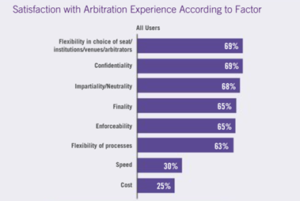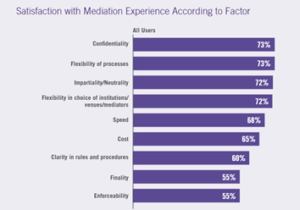It is important to first define what are hybrid mechanisms in international dispute resolution. As Voltaire once stated, ‘If you wish to converse with me, define your terms’. Hybrid mechanisms refer to processes that involve and combine more than one dispute resolution mechanism. Hybrid mechanisms take a variety of forms. By way of illustration, Singapore International Arbitration Centre (SIAC) and Singapore International Mediation Centre (SIMC) jointly provide the Arb-Med-Arb Protocol.
Issues relating to hybrid mechanisms have been covered in previous posts. Emmanuel Chua, in this Blog, discussed the perspectives of Arb-Med-Arb Protocol in Singapore and how it represented a boost for ADR in Asia. The use of mediation at different stages of the arbitral process is not a novel feature and a number of jurisdictions had already provided such a possibility before the adoption of Arb-Med-Arb Protocol. By way of example, Emmanuel Chua refers to sections 16 and 17 of the International Arbitration Act of Singapore, which states that an arbitrator may act as a conciliator if parties consent in writing. The same possibility exists under sections 32 and 33 of the Arbitration Ordinance of Hong Kong.
The inclusion of mediation and conciliation provisions in investment treaties are also on the rise. Romesh Weeramantry, Brian Chang, and Joel Sherard-Chow examined an Asian perspective of the use of mediation and conciliation in the context of investor-State disputes in this Blog. As the authors note, some investment treaties already provide for mandatory mediation and conciliation as a precondition to arbitration for the resolution of investor-State disputes. By way of example, Article 8(3) of the Hong Kong-United Arab Emirates BIT and Article 14.23 of Indonesia-Australia Comprehensive and Economic Partnership Agreement contain an investor’s obligation to refer disputes to conciliation before commencing any other available dispute resolution processes. Furthermore, Article 30 of the ASEAN Comprehensive Investment Agreement consists of a hybrid dispute resolution mechanism, which states that disputing parties may at any time agree to conciliation, which may begin at any time and be terminated at the request of the disputing investor at any time.
Following the International Dispute Resolution Survey: 2020 Final Report (the “SIDRA Survey”) on 3 July 2020, SIDRA has launched the 2021 SIDRA Survey, which calls for responses from lawyers, legal advisers, in-house counsel, and corporate executives who have experience in international commercial disputes and investor-State disputes resolution. The 2021 SIDRA Survey is available in 6 languages (English, French, Spanish, Mandarin Chinese, Russian and Arabic) and will be open until 16 May 2021. Among other dispute resolution processes (international arbitration, mediation and litigation), the 2021 SIDRA Survey will examine and study users’ perspectives, preferences, and experiences in hybrid dispute resolution mechanisms during the years 2019-2020 and provide the findings in the second half of this year. For the purposes of the 2021 SIDRA Survey, hybrid mechanisms refer to any combination of arbitration and mediation.
The findings of the 2021 SIDRA Survey will build on the observations regarding hybrid mechanisms below.
Hybrid mechanisms are the third most popular dispute resolution method in 2016-2018
In recent times, after international arbitration (74%) and international litigation (49%), hybrid mechanisms are the third most used dispute resolution mechanism (27%). When the usage was divided between legal and client users, the SIDRA Survey shows that more legal users (30%) opted for hybrid mechanisms compared to client users (23%). Overall, it was interesting to note that hybrid mechanisms are more popular than standalone mediation, as more users opted for hybrid rather than standalone mediation (26%).


Source: 2020 SIDRA Survey, Exhibit 4.1.1 and Exhibit 4.1.2
Why are hybrid mechanisms preferred over standalone arbitration and mediation?
The most important factor for users in the selection of a hybrid mechanism over standalone arbitration was the preservation of a business relationship (73%), followed by efficiency (47%), cost (47%), and speed (40%). It may come as a surprise, however, that when the usage was divided between legal and client users, the SIDRA Survey shows that preservation of business relationship was more important for legal users (81%) than for client users (56%). This finding directly challenges the popular belief that legal users tend to prefer more litigious approaches to dispute resolution.

Source: 2020 SIDRA Survey, Exhibit 9.2.2
Users of dispute resolution cited efficiency (53%) and cost (53%) as the most important factors for their choice of a hybrid mechanism over standalone mediation. This was followed by enforceability (48%), speed (45%) and finality (45%). Both legal and client users were on the same page in this regard, as there was not a significant difference when the usage was divided between legal and client users. For client users, cost (56%) and efficiency (52%) were the most important factors and for legal users, speed (53%), efficiency (53%), and cost (52%) were the decisive aspects of their choice of a hybrid mechanism.

Source: 2020 SIDRA Survey, Exhibit 9.2.4
Are users dissatisfied with standalone arbitration and mediation?
Users are not satisfied with the cost and speed of arbitration, and the efficiency of arbitrators and arbitral institutions. The SIDRA Survey shows that users were least satisfied with the cost (25%) and speed (30%) of international arbitration even though these criteria played a significant role in selecting arbitration as a dispute resolution mechanism. In addition, while efficiency was one of the most important criteria (85%) in selecting an arbitrator, users’ experience shows that only 59% of them were satisfied with this criterion. Efficiency was also the most important factor (88%) in selecting an arbitral institution. However, only 60% of users were satisfied with their experience in the efficiency of an arbitral institution.
Unlike international arbitration, users were satisfied with the speed (68%) and cost (65%) of mediation.

Source: 2020 SIDRA Survey, Exhibit 6.1.2
Only about half of the users of dispute resolution mechanisms had experiences where mediation was final (55%) and enforceable (55%). Reflecting their experiences, in ranking the factors influencing the choice of mediation as a dispute resolution mechanism, users did not rank the enforceability (67%) and finality (65%) of mediation highly.

Source: 2020 SIDRA Survey, Exhibit 7.1.3
Hybrid mechanisms can reduce the perceived disadvantages of standalone arbitration and mediation
The SIDRA Survey shows that hybrid mechanisms have the potential to reduce the perceived disadvantages of standalone arbitration and mediation, and in doing so, to achieve the efficiency that client and legal users take into account in the selection of a dispute resolution mechanism.
While arbitration remains the dispute resolution mechanism of choice for users in both common law and civil law jurisdictions, users are very dissatisfied with the costs and speed of the mechanism, which can make the whole process highly inefficient. With respect to mediation, while the Singapore Convention on Mediation establishes a regime for the enforcement of international mediated settlement agreements, it will take several years before the Singapore Convention on Mediation achieves widespread acceptance and its intended harmonizing effect similar to that of the New York Convention.
Hybrid mechanisms have the potential to reduce and minimize these disadvantages. While it is true that some users may have concerns regarding prolonging already time-consuming arbitration, mediation during ongoing arbitral proceedings may help parties to come to a settlement, which can save a significant amount of time and cost. Mediating a dispute can also save parties’ business relationship, which is usually a high priority for client users. When it comes to mediation, hybrid processes can provide the enforcement regime of the New York Convention to mediated settlement agreements that are recorded as consent arbitral awards. As a result, hybrid processes can reduce the perceived disadvantages of mediation in relation to the lack of finality and enforceability.
Have users’ attitudes towards hybrid mechanisms changed since 2018?
Hybrid processes are becoming more and more popular. After the SIAC-SIMC Arb-Med-Arb Protocol, a number of international dispute resolution service providers have followed suit, including the Vienna International Arbitral Centre’s Arb-Med-Arb model clause and Vietnam International Arbitration Centre and Vietnam Mediation Centre’s Arb-Med-Arb protocol.
While the SIDRA Survey has studied the perspectives, preferences, and experiences of users during the years 2016-2018, it is important to analyze any new developments in users’ attitudes towards and experiences in hybrid dispute resolution processes.
The 2021 SIDRA Survey can be accessed at: https://smusg.au1.qualtrics.com/jfe/form/SV_eJRTOTOlwNtYf5P?so=05
The author gratefully acknowledges the valuable comments received from Ryce Lee.
________________________
To make sure you do not miss out on regular updates from the Kluwer Arbitration Blog, please subscribe here. To submit a proposal for a blog post, please consult our Editorial Guidelines.


